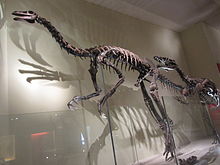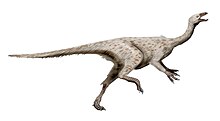Beishanlong
| Beishanlong Temporal range: Late Aptian,
| |
|---|---|

| |
| Restored skeleton of Beishanlong and Xiongguanlong | |
| Scientific classification | |
| Domain: | Eukaryota |
| Kingdom: | Animalia |
| Phylum: | Chordata |
| Clade: | Dinosauria |
| Clade: | Saurischia |
| Clade: | Theropoda |
| Clade: | †Ornithomimosauria |
| Family: | †Deinocheiridae |
| Genus: | †Beishanlong Makovicky et al., 2010 |
| Species: | †B. grandis
|
| Binomial name | |
| †Beishanlong grandis Makovicky et al., 2010
| |
Beishanlong is a
Discovery and naming

Three fossils of Beishanlong were in the early twenty-first century found in northwestern China at the White Ghost Castle site, in the province of
Beishanlong lived in the late Aptian
Description

Beishanlong is of a considerable size, approximating the largest-known individuals of Gallimimus, which have been estimated to reach eight metres. According to the description, Beishanlong "is one of the largest definitive ornithomimosaurs yet described, though histological analysis shows that the holotype individual was still growing at its death." A histological study of the bone structure of the fibula found thirteen or fourteen growth lines, indicating the individual was subadult, though growth had already slowed.[1] The size of this subadult individual is estimated at 5.9–7 m (19–23 ft) in length and 375–626 kilograms (827–1,380 lb) in body mass.[3][1][4][5]
The build of Beishanlong was rather robust. The arms and legs were long, though lacking the extremely elongated hands, feet and claws of later forms.[1]
Classification
Beishanlong was by the describers assigned to the Ornithomimosauria, in a more basal position. Beishanlong was closely related to fellow ornithomimosaurian Harpymimus. Together they formed a polytomy with the main ornithomimosaurian branch just below Garudimimus.[1] In 2014 Yuong-Nam Lee et al. recovered Beishanlong as a member of Deinocheiridae basal to a clade containing Garudimimus and Deinocheirus.[6]
See also
References
External links
- "Field Museum palaeontologist leads study on two new dinosaurs from China" ScienceCentric.com
